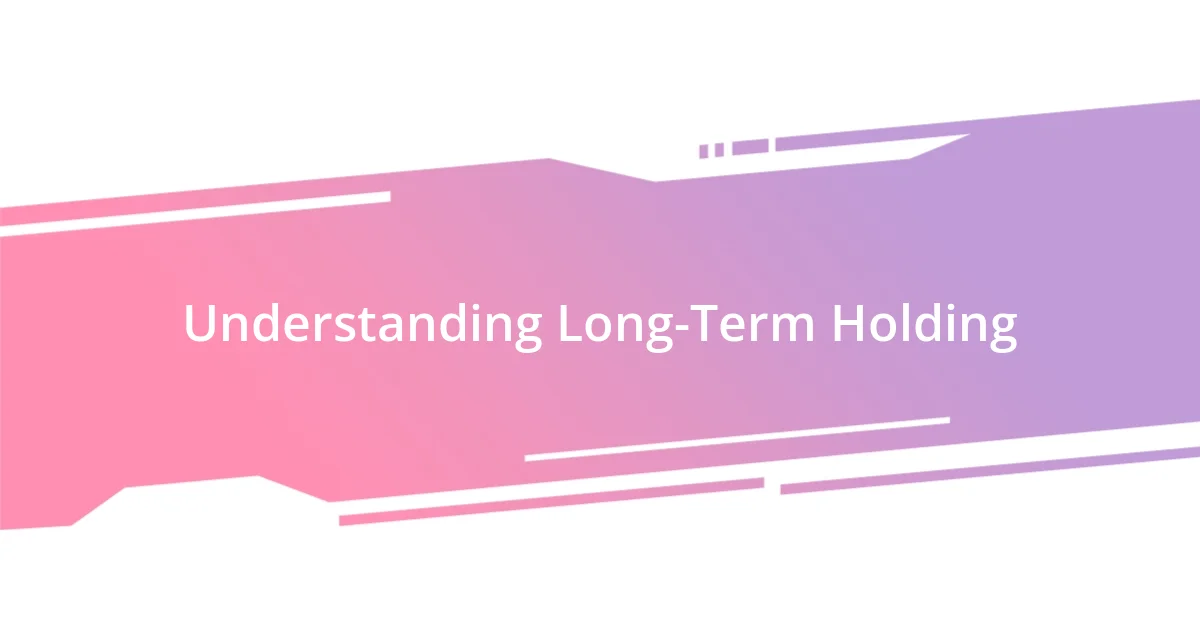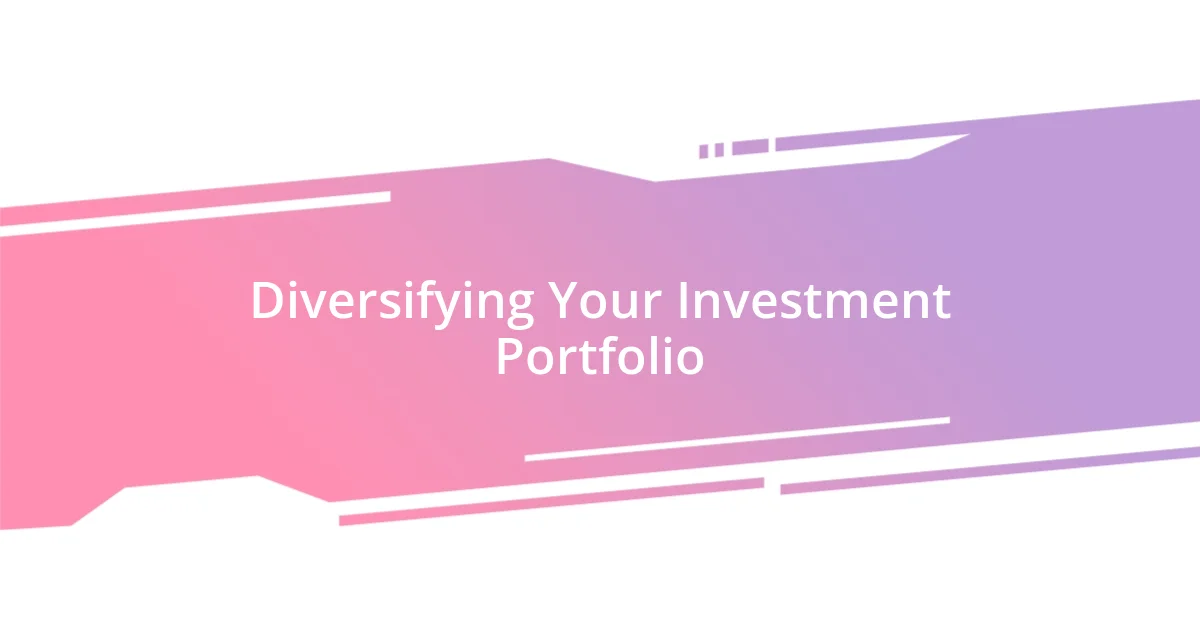Key takeaways:
- Long-term holding, or HODLing, emphasizes patience and emotional resilience, often leading to greater rewards compared to quick selling during market fluctuations.
- Diversification across various asset classes can protect investments from downturns and reduce anxiety, enabling long-term growth and confidence in strategies.
- Regular monitoring of investments and learning from past experiences—both failures and successes—are crucial for refining strategies and ensuring alignment with long-term goals.

Understanding Long-Term Holding
Long-term holding, or HODLing as many in the cryptocurrency community say, is more than just a strategy; it’s a mindset. I remember when I first started investing. The thrill of quick gains tempted me to sell, but watching my friends hold through market fluctuations taught me that patience often yields greater rewards. Isn’t it interesting how our emotions can drive our decisions, sometimes leading us away from what we know to be a sound strategy?
When you commit to long-term holding, you’re essentially betting on the future potential of your investments. I often think of it as planting a tree. At first, there’s not much to see, and it can feel tedious, but with consistent nurturing and care, that tree can grow into something magnificent. Isn’t it worth considering how many opportunities we might miss if we let fear dictate our choices?
This approach isn’t without its challenges. There were moments when market dips made my heart race, causing me to question my choices. Yet, I’ve learned that staying the course can be as valuable as any market analysis. After all, how often have we seen short-term volatility lead to long-term opportunity? The emotional resilience developed through this experience is invaluable, teaching us not just about the market, but also about ourselves.

Benefits of Long-Term Investing
Long-term investing offers several key advantages that often go unnoticed at first glance. One benefit that stands out to me is the power of compounding returns. I still recall the moment I truly understood how reinvesting dividends could significantly enhance my investment over the years. Watching my money work for me, like a snowball gradually growing as it rolls downhill, was a game-changer. This long-term perspective allows investors to benefit from the exponential growth that can occur over time.
Another significant benefit is reduced stress and emotional turmoil. I can’t tell you how liberating it feels to step back from daily market fluctuations. There were times when I would anxiously check stock prices multiple times a day, but adopting a long-term strategy has calmed my nerves. Instead of worrying about what’s happening in the moment, I focus on the overall trajectory of my investments. It’s like enjoying a good book—you don’t flip to random pages, but rather savor the flow of the entire story.
Moreover, long-term investing fosters discipline and patience. I remember a particular investment that initially seemed stalled, leading me to doubt its potential. However, sticking with it has taught me the value of patience and how sometimes, the best choice is simply to wait. Through these experiences, I’ve learned that those who can ride out the storms are often the ones who reap the most rewarding harvests in the end.
| Benefits | Description |
|---|---|
| Compounding Returns | Reinvesting dividends leads to exponential growth over time. |
| Reduced Stress | Long-term focus diminishes the anxiety tied to daily market fluctuations. |
| Discipline and Patience | Encourages a mindset that values waiting and trusting the process. |

Setting Clear Investment Goals
When I think about setting clear investment goals, I realize how crucial this foundation is for long-term holding. Initially, I approached investments haphazardly, lacking a concrete plan. Over time, I learned that having specific goals helps anchor my decisions, guiding me through the inevitable ups and downs of the market. It’s like navigating with a map; without a clear destination, you’re at the mercy of every detour along the way.
To help clarify your investment objectives, consider these key aspects:
- Time Horizon: Determine how long you intend to hold your investments before needing the funds.
- Risk Tolerance: Assess how much volatility you’re comfortable with and what level of loss you can accept.
- Financial Milestones: Identify specific financial goals you want to achieve, such as saving for retirement, purchasing a home, or funding education.
- Diversification: Decide on how much you want to allocate to different asset classes based on your goals and risk profile.
- Regular Review: Set a schedule to revisit your goals and adjust your strategy as needed, ensuring you remain aligned with your long-term vision.
In my own experience, I remember vividly the moment I defined my investment goals. It was a turning point that transformed my approach. I had always viewed my portfolio as a collection of stocks, but once I articulated my intentions—saving for my children’s education and retirement—it became clear what actions I needed to take. By linking my investments to my life’s priorities, I felt more committed and less swayed by fleeting market changes. Seeing those goals in black and white not only motivated me but also brought a sense of peace in knowing I was working towards something significant.

Diversifying Your Investment Portfolio
Diversifying your investment portfolio is like painting a picture; if you only use one color, the result can be quite dull. Through my own journey in investing, I’ve realized that spreading my capital across various asset classes—stocks, bonds, real estate, and even some alternative investments—has not only protected me during downturns but also opened doors to opportunities I hadn’t initially considered. The first time I added real estate to my portfolio, I was amazed at how it could offset my stock market risks, similar to balancing flavors in a recipe for a satisfying meal.
Have you ever felt the anxiety of watching a single stock plummet? I certainly have! I remember holding onto a tech stock that seemed promising until it nosedived unexpectedly. At that moment, I wished I had diversified more. By embracing a broader range of investments, I could have softened the blow. It’s a bit like being on a tightrope; having multiple supports below me gives me the confidence to take risks without the fear of falling flat.
Moreover, diversification provides an emotional buffer. I often reflect on how much easier it has been to weather market fluctuations when I know my investments are not all tied to one sector. The peace of mind that comes with a balanced portfolio allows me to focus on long-term growth, rather than the daily noise of market changes. Have you ever considered what it feels like to invest with confidence? For me, it’s about knowing that each component of my portfolio plays a role in a larger strategy, much like a well-rehearsed team ready to tackle any challenge that comes their way.

Analyzing Market Trends
When analyzing market trends, I’ve found that staying informed is essential. It’s like having a pulse on the economy. I often track indicators such as GDP growth, employment rates, and consumer confidence. These metrics signal the health of the market and influence my investment decisions. Have you noticed how a company’s earnings report can send prices soaring or plummeting? This kind of volatility underscores the importance of studying trends rather than reacting to every piece of news.
During my investment journey, I realized that understanding patterns over time—like seasonal effects or cyclical changes—enhances my strategic viewpoint. I recall learning about the historical performance of stocks during various economic cycles. Armed with this knowledge, I felt more prepared to navigate downturns. For instance, I remember a period when tech stocks faced challenges. Instead of panic selling, I analyzed the market conditions and held firm, which ultimately paid off. This experience taught me that patience, combined with trend analysis, can be transformative.
Moreover, trends aren’t just about numbers; they’re about narratives. I enjoy looking at how market sentiment shifts over time. For example, I often check social media and online forums to gauge the buzz around emerging technologies or industry disruptions. I remember when electric vehicles began to capture everyone’s attention; it felt electrifying! Understanding this kind of enthusiasm can help align my investments with trends that resonate with consumers. How do you perceive market sentiment? I’ve come to appreciate that paying attention to these sentiments adds another layer to my long-term investment strategy.

Monitoring Your Investments Regularly
Monitoring your investments regularly is like tending to a garden; without consistent care and attention, your plants can become overrun with weeds. I’ve experienced this firsthand when I overlooked some underperforming assets in my portfolio. When I finally checked in after several months, I realized they had dragged down my returns more than I expected. This experience taught me that regular reviews not only help weed out poorly performing investments but also allow me to identify new opportunities that align better with my goals.
I’ve made it a habit to set reminders for myself every quarter to dive deep into my portfolio. During one of these sessions, I stumbled upon a burgeoning trend in green energy. I remember feeling that rush of excitement, akin to discovering new blooms in my garden. It was clear that staying engaged with my investments not only kept me informed but also reignited my passion for smart investing. Do you regularly check your investment health? I find that by keeping my finger on the pulse, I’m more prepared to adjust my strategies proactively rather than reactively.
Moreover, employing tools for investment tracking has made a world of difference. Using apps that alert me to significant changes or trends in my portfolio has added a layer of confidence to my investing approach. I recall a moment when an app notified me of a potential buying opportunity just as a stock I loved dipped in value. It felt like catching a wave right at the right moment—thrilling! I believe that having these resources at my fingertips enhances my ability to monitor my investments effectively and with ease. How do you keep track of your investments? Finding the right tools can truly elevate your investment journey and keep you engaged in the long run.

Learning from Past Experiences
Reflecting on my investment journey, I’ve learned that every setback serves as a valuable lesson. For instance, during a previous market downturn, I decided to hold onto a stock that wasn’t performing well, convinced it would bounce back. Unfortunately, it didn’t, and watching my investment erode over time was disheartening. This taught me the importance of not just holding onto hope but also conducting a thorough assessment of whether my investments still align with my long-term strategy. Have you ever held onto something too long, waiting for the next big break? I certainly have, and now I ensure that I remain pragmatic rather than sentimental.
I’ve also discovered that looking back at successful decisions can be just as informative. I remember a specific instance when I invested in a company focused on renewable energy early on. While my friends were skeptical, I trusted my research and, eventually, my portfolio benefited considerably. This experience reinforced my belief in the power of diligent research over popular opinion. Isn’t it empowering to rely on your understanding instead of just following the crowd? I always encourage myself to analyze both triumphs and failures; each holds a wealth of learning.
Another critical aspect I’ve encountered is the value of diversifying based on historical performance. After witnessing one of my tech investments take a nosedive, I realized that relying heavily on a single sector can be risky. I gradually started to explore industries that have historically shown resilience, such as utilities and consumer staples. How does your approach to diversification reflect your investment experiences? My focus on diversification has allowed me to cushion my portfolio against unexpected market shifts, and I see it as a safety net built from lessons learned along the way.














